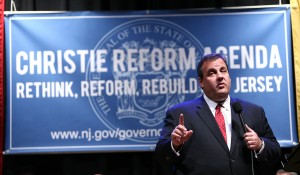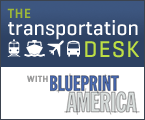Tom McNamara, Blueprint America
After making headlines for weeks, yesterday New Jersey Governor Chris Christie made it official: He’s killing the commuter rail tunnel between Manhattan and New Jersey. The project is too expensive, he says, and his state doesn’t have the money to cover its share of the costs. The demise of the largest public works project in decades illustrates the stark political choice many voters will make next week: either spend our way out of the recession with big projects like high-speed trains and tunnels or save our way out with good old fashioned belt-tightening.
Christie made his choice clear last week with a childhood story: “In our house, when I used to go to my mother and say, ‘I’d like something new, I’d like to buy something.’ My mother would look at me and say, ‘Well, of course, Christopher, you can have that, just go in the back yard and take the money off the money tree. You know where that is, right?’”
The New Jersey governor is only in his first year of office and not up for reelection, yet he has been crisscrossing the country this election season endorsing Republican candidates and preaching his wildly popular brand of fiscal conservatism.
In closing the story of Christopher and the money tree, he made a connection to the unchecked spending he sees today: “There is no money tree in Washington, D.C. … To me it is a moral imperative to say no to these things.”
Does Chris Christie have his finger on the country’s pulse?
Nearly two years after an economic stimulus steeped in infrastructure building promises and $787 billion in government spending, Americans by and large have had enough. In a September 2010 Rassmusen poll, 61 percent of U.S. voters said cutting government spending and deficits would do more to create jobs than President Obama’s call last month for $50 billion more in infrastructure spending, what’s being dubbed”stimulus part two.”
And while Christie isn’t the first politician to take a stand against Washington, he certainly turned down an awful lot of money: $6 billion in combined federal, regional and stimulus funds for a new and needed (even Christie thought it was a good idea) commuter rail tunnel. In fact, for saying no, New Jersey could owe the feds some $600 million it has already spent on the project.

NJ Governor Chris Christie holds a Town Hall Meeting on his Reform Agenda for the state in Moorestown, NJ. Photo: NJ Governor's Office/Tim Larsen
It’s not every day a governor turns down billions in infrastructure spending. It was estimated that the project would have created 6,000 new jobs, greatly lessened commute times and increased property values for state residents. But that isn’t exactly the deal Christie walked away from. The tunnel would have left the same residents on the hook for $6 billion in projected cost overruns on top of the $3 billion the state was already obligated to pay.
Secretary of Transportation Ray LaHood, a former Republican Congressman, took an impromptu trip to the New Jersey capitol last week to convince Christie to change his mind. But, in the end, the feds were unable to calm the governor’s fears that cost overruns would trash New Jersey’s budget. Later, the DOT chief only had this to say by way of Twitter, “Is it just me, or is it hard to argue against writing the next chapter in American innovation?”
No train
Apparently, it is getting easier to argue against the next chapter of American innovation, especially if it’s being proposed by the Obama administration. If elected, Republican gubernatorial candidates from Wisconsin, Ohio, Florida and California are promising to say “no” to federal dollars for high-speed rail. Being against massive government investment in high-speed rail isn’t hurting their chances either. The anti-rail candidates are in command in Wisconsin, Ohio, and Florida; and California is a tossup. And it’s no coincidence that Christie has campaigned in all of these states.
High-speed rail is one of President Obama’s signature initiatives. In his State of the Union address this year, the president backed up his national rail vision by announcing that $8 billion in stimulus money would be distributed to various states, including Wisconsin, Ohio, Florida and California, to get the country’s next generation of transportation moving.
“The bottom line is that high-speed rail is a national program that will connect the country, spur economic development and bring manufacturing jobs to the U.S.,” said Secretary LaHood in a statement. “It will also transform transportation in America, much like the Interstate highway system did under President Eisenhower. It’s hard to imagine what would have happened to states like Ohio and Wisconsin if their leaders had decided they didn’t want to be connected to the rest of the country back then.”
Wisconsin
More than $810 million in federal stimulus money is going to build a high-speed train line between Milwaukee and Madison. Republican gubernatorial candidate Scott Walker has made that issue central to his campaign, even holding a “Stop the Train” rally over the summer. Walker argues that taking the money will forever obligate the state to spend $7 million to $10 million a year. High-speed rail will not be self-supporting, he says. His website, NoTrain.com, runs an advertisement in which he calls the rail project a boondoggle. “I’m Scott Walker,” he says in the video, “and if I’m elected as your next governor, we’ll stop this train.”
Ohio
Republican candidate for governor John Kasich has promised to kill a $400 million federal stimulus project to connect Cleveland, Columbus and Cincinnati by high-speed rail. In a recent debate, Gov. Ted Strickland, a Democrat seeking re-election, was dumbfounded his opponent would return that much money, “Your position, quite frankly, really puzzles me,” Strickland said.
Florida
Rick Scott, the Republican candidate for governor, has flip-flopped on the high-speed rail line from Orlando to Tampa. In a CNN debate Monday night, Scott said he’d pull the plug on the project if the state had to pay for any portion. The next day, Scott softened, “I would go through first and wait until we can see the feasibility study and see what it’s going to cost taxpayers. Then I would make the decision,” he said.
All told, after an initial $1.25 billion in stimulus earlier this year and another $800 million just this week from the feds, Florida only has to pay for 20 percent of the project.
California
After an investment of $2.3 billion in federal stimulus, Republican candidate for governor Meg Whitman has maintained that the time for the $45 billion high-speed rail plan, connecting San Francisco and Los Angeles, is not now. “In the face of the state’s current fiscal crisis, Meg doesn’t believe we can afford the costs associated with new high-speed rail at this time,” said Tucker Bounds, a campaign spokesman, to The New York Times.
However, as the California High Speed Rail Blog points out, the costs for the project are not associated with the state’s budget, and any delays could only jeopardize the stimulus money.
And just this week, the feds announced that another $902 million is on the way for high speed rail development in the state.
A 21st 20th century infrastructure
It remains to be seen how much power fiscal conservatives will have in saying “no” to high-speed rail and other big infrastructure investments. These deficit hawks, demanding to know where Chris Christie’s proverbial money tree is, could stand in the way of the Obama administration’s goal of bringing America’s infrastructure into the 21st century.



